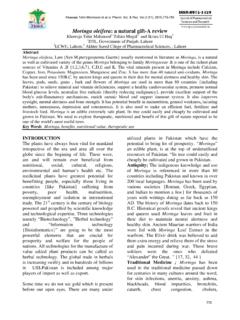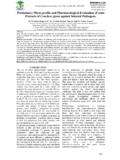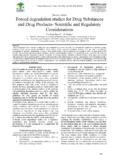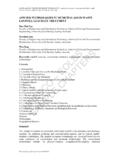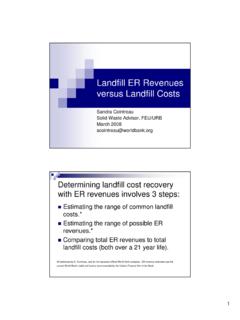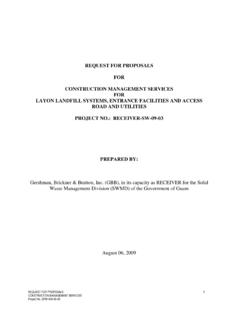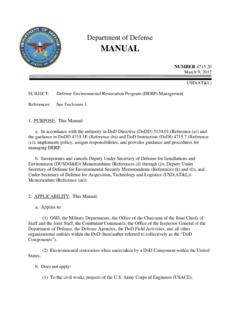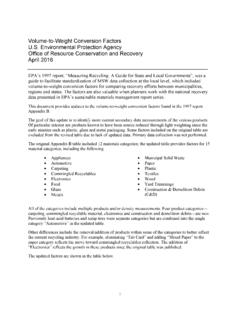Transcription of 09 REVIEW ARTICLE - PharmaInfo
1 Hospital waste Disposal: A REVIEW ARTICLE Nosheen Arshad*, Shamail Nayyar *, Dr. Fatima Amin* and Dr. Khawaja Tahir Mahmood** *Department of Pharmacy, Lahore College for Women University, Lahore, Pakistan **DTL, Lahore, Pakistan Abstract This is a REVIEW paper which is prepared from the surveys of hospitals and research studies. Hospital waste management in the world is a formal discipline and does occupy a critical place in the management of health care sector. The management of hospital waste requires its removal and disposal from the health care establishments as hygienically and economically as possible by methods that all stages minimizes the risk to public health and to environment.
2 To analyze the present situation analysis of medical waste management systems was performed to understand the various handling and disposal procedures, the knowledge and awareness of individuals involved in medical waste generation, handling and disposal, and the potential impacts of the waste stream on both human health and the natural environment. The method adapted for present study was literature REVIEW and survey method. The data collection was done through questionnaire (data collection form), informal interviews and site visits. It was found that a variety of methods were used by the medical facilities to dispose their wastes including burning burial, entombing, selling, dumping, and removal by municipal bins.
3 The waste disposal practice was found to be quite unsafe, and both clinical and non-clinical wastes were found to be thrown together. There was insufficient awareness of the magnitude of the medical wastes issue by concerned individuals at different levels from director or divisional head to waste pickers. There was no safety measure observed in dealing with waste disposal or laboratory analysis of infectious diseases. Medical waste incineration is identified as the most preferred disposal method. It is important to point out that there is a great potential to emit air toxic pollutants from such incinerators if improperly operated and managed.
4 However there are some institutions which practice the most sound hospital waste management practices such as Shaukat Khanum and Shalamar. From this study it can be said that proper waste management strategy is needed to ensure health and environmental safety. Key words: Hospital waste , Hospital waste management( HWM), Hospital waste disposal INTRODUCTION Hospital waste management is an important process that must be dealt with diligently. The management of hazardous waste material requires specific knowledge and regulations and it must be carried out by specialists in the field. Heaps of litter is taken to dumpsites in developed countries. However, in developing countries, waste mostly ends up on road sides and empty plots.
5 Untreated waste bears an economic cost for residents of the area and is also an environmental hazard. Increasing pollution leading to environmental changes and economic cost related to waste in terms of health hazards and negative impact on infrastructure have changed the way authorities view it. Though waste management is a relatively new phenomenon, it has caught the attention of governments all over the globe. Today the term waste management covers collecting, sorting, processing, recycling and reusing materials that would otherwise be considered as useless. This ARTICLE is concerned with comparing practices for the management of healthcare waste using five case study hospitals.
6 Compliance with the waste Management Rules 2005, under the Environment Protection Act (1997), of the Government of Pakistan was used as the standard. Until fairly recently, medical waste management was not generally considered an issue. In the 1980s and 1990s, concerns about exposure to human immunodeficiency virus (HIV) and hepatitis B virus (HBV) led to questions about potential risks inherent in medical waste . Thus hospital waste generation has become a prime concern due to its multidimensional ramifications as a risk factor to the health of patients, hospital staff and extending beyond the boundaries of the medical establishment to the general population.
7 [1] Hospital waste refers to all waste , biologic or non- biologic that is discarded and not intended for further use. Medical waste is a subset of hospital waste ; it refers to the material generated as a result of diagnosis, treatment or immunization of patients and Nosheen Arshad et al /J. Pharm. Sci. & Res. (8), 2011,1412-14191412associated biomedical research. [2] Biomedical waste (BMW) is generated in hospitals, research institutions, health care teaching institutes, clinics, laboratories, blood banks, animal houses and veterinary institutes. [3] Hospital waste management means the management of waste produced by hospitals using techniques that will check the spread of diseases.
8 [4]In developing countries, awareness regarding hospital waste management in terms of its segregation, collection, storage, transportation and disposal is lacking.[5,6] Studies in Pakistan show that around kg of waste /bed/day is produced out of which can be categorized as risk waste .[7] The management of hospital waste poses a major problem in most of the countries. In recent years, medical waste disposal has posed even more difficulties with the appearance of disposable needles, syringes, and other similar items. There are several categories of hospital wastes according to their weight density and constituents.
9 The World Health Organization has classified medical waste into different categories, which are, infectious, sharps, pathological, pharmaceutical and radioactive. There are several categories of infectious waste like human tissues and body parts, animal carcasses, syringes, blades, saws, drugs, vomits, urine, chemicals and fluid from laboratories. Infectious health-care waste is a major cause of HIV/AIDS, hepatitis B and C viral infections. These viruses are generally transmitted through injuries from needles and sharp objects, which are contaminated with human blood. There are however, numerous other diseases which could be transmitted by contact with health-care wastes.
10 These are urinary tract infections, respiratory tract infections, wound infections, bacteremia, and skin infections etc.[WHO 2004,8] Healthcare waste disposal in each country depends upon a number of factors including sensitization level of the health managers as well as other professionals, existing local legislations and available resources. In Pakistan, despite the existence of Pakistan Biosafety Rules 2005, neither proper hospital waste management systems have been developed in various health institutions nor the concerned health professionals and managers are aware of the gravity of the situation resulting therein.
